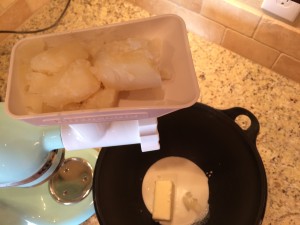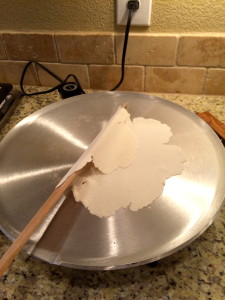While everyone in our family agrees that we can skip the lutefisk at Christmas, it just wouldn’t be right to not have lefse. So, I made a single batch the night before Christmas Eve.
I used this recipe from Allrecipes. It turns out great every time and is pretty basic.
Alright, I started by peeling and boiling ten pounds of russet potatoes. I always salt the water when I boil potatoes and pasta, but it’s not necessary for making lefse and you could end up with salty lefse. Don’t be like me and dump salt in the boiling water without thinking. The potatoes were a tad salty. No one seemed to notice at Christmas, but……..I knew.

I used the grinder attachment on my mixer to rice the potatoes into a large Tupperware bowl of salt, sugar, heavy cream and butter.

Ricing the potatoes is my favorite part of the process.

The butter will be melted by the time the last of the potatoes are riced so it’s time to cover them and set aside until they are cool. I usually use the refrigerator to aid in the process.
When the potatoes are completely cooled. As in, absolutely no warm spots that could turn the flour into glue, mix in the flour. I use the recommended amount or even a little less. It should be just enough flour to barely bind the potatoes together. There are other lefse recipes out there that use more flour and you will probably end up with a prettier, more uniform result, but I love my lefse super thin and tender, so I prefer to use less flour in the dough and add in as needed while I roll it out. Also, I left my potatoes in the refrigerator too long so they ended up lumpy and cold. Don’t be like me.

A cooling rack with flour sack towels works great for softening the lefse as it cools, so I made sure to have that ready before my hands were covered in gunk from making the potato balls.

Next, I formed all the dough into balls.

Turned the lefse iron on to the highest setting (500 F) (the recipe says to 400, but I’ve had the best luck with a higher setting)

and set out my lefse sticks. I have five or six sticks, but these two are my favorite. I usually end up using the one on the left a little more, but each piece of lefse turns out differently and sometimes the other one is better for moving the finished lefse to the cooling rack.

Once I had everything set up, I worked a handful of flour into the fabric cover over the lefse board.

Then, I flattened a ball of dough into a small disk

and rolled it out as flat as possible. I use a special grooved rolling pin covered in a stretchy cloth for rolling out the dough and I work a lot of flour into the cloth on the rolling pin.

After the lefse is rolled out, I use a smaller grooved roller to smooth the edges out as thin as possible. It also leaves a nice little pattern on the lefse that I like.
If the board is floured sufficiently, you will have no problem sliding a stick under the lefse and transporting it to the hot cooktop.

Carefully roll it off the stick.

As you can see, my lefse rolling skills are a little rusty and I couldn’t quite achieve the rounded edges that lefse should have.

After a minute or so, the lefse will develop some brown spots, so flip it over to brown on the other side.

Don’t worry about any crispy edges; stacking the lefse to cool between the towels will help it to soften.
The finished product was pretty tasty. I like to spread it with butter, sprinkle it with brown sugar, and roll it up like a taquito.

Norwegian Lefse
10 pounds potatoes, peeled
1/2 cup butter
1/3 cup heavy cream
1 tablespoon salt
1 tablespoon white sugar
2 1/2 cups all-purpose flour
Cover potatoes with water and cook until tender. Run hot potatoes through a potato ricer. Place into a large bowl. Beat butter, cream, salt, and sugar into the hot riced potatoes. Let cool to room temperature.
Stir flour into the potato mixture. Pull off pieces of the dough and form into walnut size balls. Lightly flour a pastry cloth and roll out lefse balls to 1/8 inch thickness.
Cook on a hot (400 degree F/200 C) griddle until bubbles form and each side has browned. Place on a damp towel to cool slightly and then cover with damp towel until ready to serve.


























